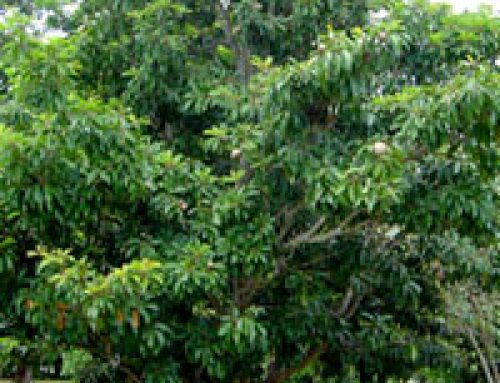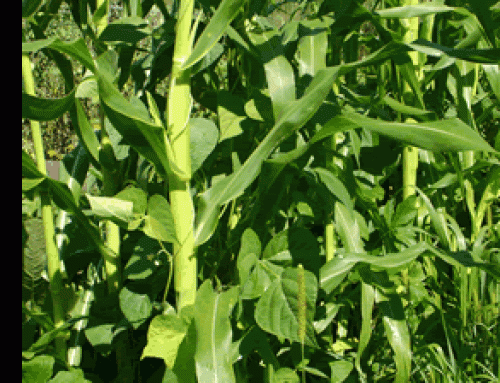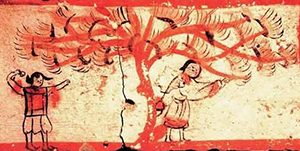
Food history: Uighur women picking mulberries (ca. 400s AD)
Going hungry
Throughout most of history, most people never got enough to eat. Many people starved to death. Food was much more expensive than it is today, and governments helped people out less than they do now. Even farmers often went hungry when city people took all their food for themselves as taxes or tithes, or if the weather was bad and storms or viruses ruined the crop.
More about taxes
More about viruses
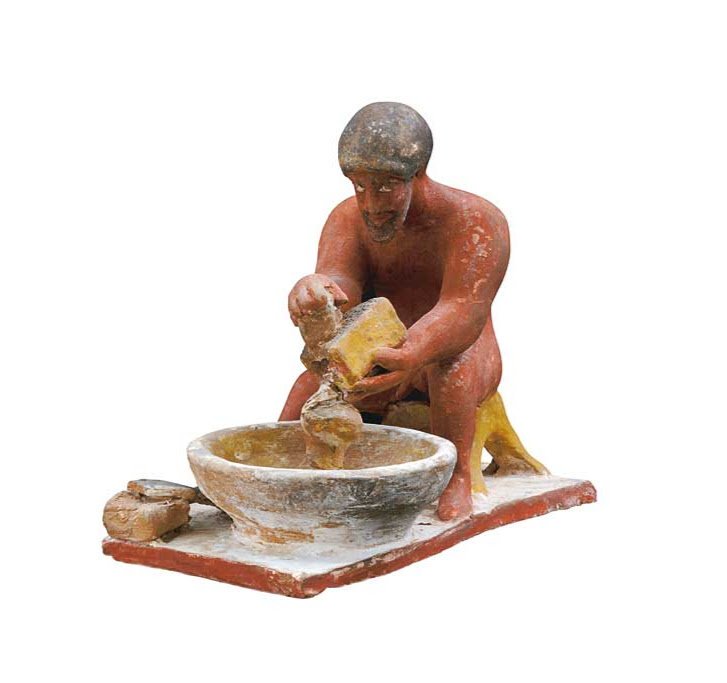
A terracotta figurine of a man grating a block of yellow cheese, from ancient Greece (Boston MFA)
Children went hungry more than their parents, because if the parents starved the children would probably die soon anyway from neglect. If the parents survived the famine, but the kids starved, they could always have more kids.
Life expectancy in history
When people could get food, the food people ate varied a good deal from time to time and from place to place. There are some things all these times and places had in common, though.
Fish, shellfish and seaweed

Stone carving of a fish (San Francisco, ca. 7000 BC)
First, one reason food was so expensive was that there was no refrigeration or freezers. It was very hard to keep food from going bad. One strategy most people used all over the world was to eat a lot of fish and shellfish like crabs, mussels, clams, and oysters. People also ate a lot of seaweed.
History of fishing
Those foods kept themselves fresh and alive. You could just go fishing or gathering shellfish and seaweed fresh for every meal. But as populations got bigger, people were also careful not to over-fish and use up their seafood. So they ate other things when they could, and saved the seafood for emergencies.
Smoking, drying, fermenting, and pickling
People also worked hard to preserve foods that didn’t keep. The most important method was drying food and storing it carefully: people stored wheat and barley and millet and rye and sorghum and rice and corn.
Where is barley from?
When did people start to eat rice?
What is rye flour?
Where is corn from?

A fast-food thermopolium in ancient Ostia, near Rome
They also dried fruit to make raisins, dried figs and dates, dried beans, dried corn, and dried apples. In Peru, people freeze-dried potatoes.
History of potatoes
Where are figs from?
What about dates?
People pickled eggs and vegetables, meat, and fish in brine (salty water) to make pickles and garum, a fermented fish sauce. Some people fermented grape juice and apple juice and barley to turn them into wine and cider and beer. Other people made milk into yogurt and cheese. Many people smoked meat from pigs to make ham and bacon, or they preserved meat in honey.
History of honey
How do you make beer?
Where does cheese come from?
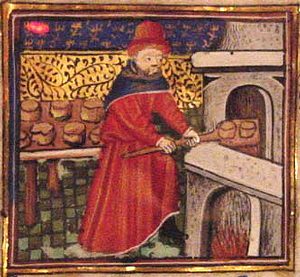
Man baking bread in medieval Europe
Seasonal, local food
Second, because it was so hard to carry things from one place to another without canals or trains or trucks, most people could only eat local, seasonal food.
If there was a shortage of food because of bad weather or crop diseases, or because soldiers had wrecked the crops in a war, people starved.
People in different places ate very different foods, depending on what plants grew and what animals lived there. In China, people ate soybeans, rice, tea, chickens, citrons, and peaches. But in India, it was sugar and bananas.
History of tofu
Where do chickens come from?
History of sugar
More about bananas
In Central Asia, where people raised cattle, they ate a lot of yogurt, cheese, and beef, but also apples and carrots. West Asian people ate barley bread, chickpeas, lentils, olive oil, and wine. In Africa, people ate figs, yams, palm oil, beer, coffee beans, teff, and millet. Further north in Europe, they drank beer too, but with salted ham and bacon, butter, oats and rye bread.
Where are apples from?
How did carrots become orange?
What are chickpeas?
Across the Atlantic Ocean in South America, people enjoyed potatoes, corn, peanuts, tomatoes, peppers, and chocolate. Further north people ate turkey, sweet potatoes, sunflower seeds, salmon, and wild rice.
History of tomatoes
Where does chocolate come from?
What about sweet potatoes?
Importing new foods
But another important strategy people had was to bring new foods to their area from other places. Central Asians brought pigs and cows and apples to West Asia around 7000 BC. Dates first came from West Asia to Africa about 4000 BC.
More about pigs
Where are cows from?
Wheat first reached China from West Asia about 2500 BC; chickens first reached West Asia from India about 1000 BC. Bananas reached Africa from India around 500 BC, and rice left India for West Asia and Europe a few hundred years later.
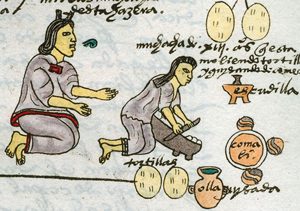
Aztec women making tortillas ca. 1520 AD
The Silk Road and food history
The strength of Central Asia and the rise of the Silk Road between 500 BC and 1500 AD encouraged a lot more trading of food all across Asia. More Central Asian cinnamon and pepper began to reach Europe and China.
History of cinnamon
All about black pepper
Bee-keeping traveled from West Asia to China. Peaches, lemons, and oranges returned in the other direction. Central Asian food scientists bred better carrots and sold them.
Oranges and lemons
History of peaches
and also almonds

Selling sugar in medieval Europe(Theatrum sanitatis, codice 4182 della R. Biblioteca Casanatense. Rome, ca. 1375 AD)
Sugar spread from India all over Asia and even as far as Europe and North Africa; coffee and tea spread across Asia from Africa and China.
Coffee’s from Africa
And tea is from China
The Columbian Exchange

Sweet potato noodles from Sichuan in SW China
When Europeans began sailing across the Atlantic Ocean to the Americas about 1500 AD, they brought sheep and pigs and chickens, wheat, beehives, sugar, and apples with them. A little later, it was tea and coffee.
From the Americas to Europe, they sailed back with potatoes, tomatoes, corn on the cob (maize), turkey, chili peppers, squash, chocolate, and avocados. They brought American sweet potatoes to China, where poor people started to eat sweet potatoes as their main food.
Historians call this trading of food between the Americas and Afro-Eurasia the Columbian Exchange.
African food
Chinese food
Central Asian food
Indian food
Native American food
Central American food
Egyptian food
West Asian food
Greek food
German food
Roman food
Islamic period food
Medieval food
Bibliography and further reading about the history of food:
Food, by Fiona MacDonald and others (2001). For kids, facts about food from all over the world. A little preachy.
Or try reading Food and Society in Classical Antiquity, by Peter Garnsey (1999). Garnsey has written a lot about ancient food, and is an expert, but he writes very clearly.
And get Food in Antiquity: A Survey of the Diet of Early Peoples, by Don and Patricia Brothwell (1998). Pretty specialized, but the book tells you where foods came from, and how they got to other places, and what people ate in antiquity. Not just Europe, either!
Food: A Culinary History from Antiquity to the Present, by Jean Louis Flandrin, Massimo Montanari, Albert Sonnenfeld. (1996). Hard going because it is translated from French, but Flandrin was one of the world’s great food historians.
